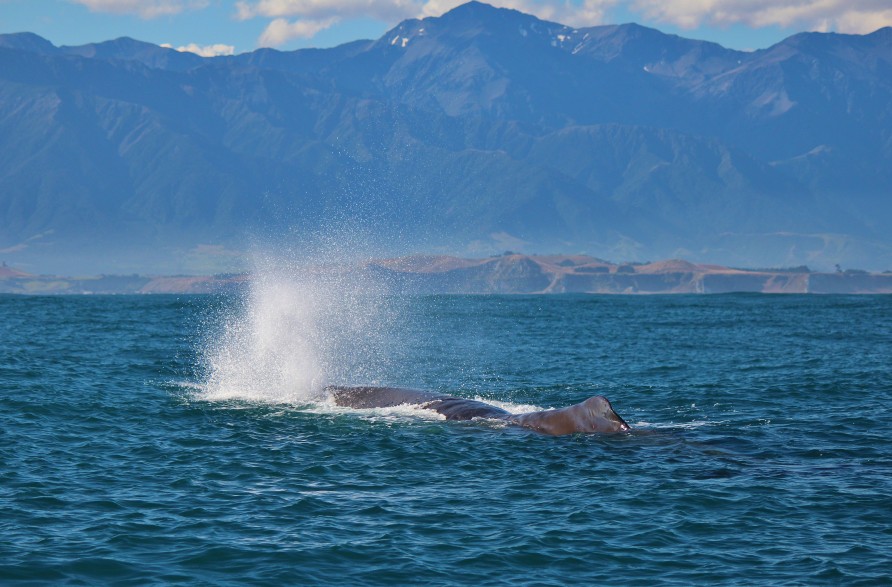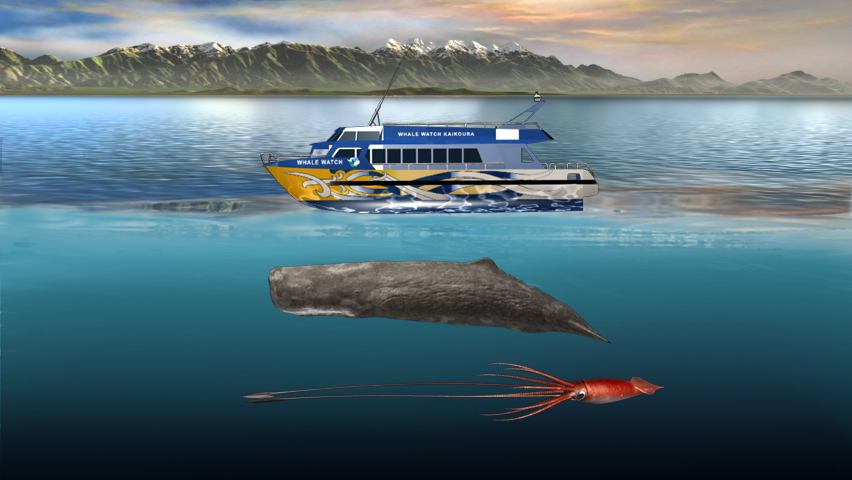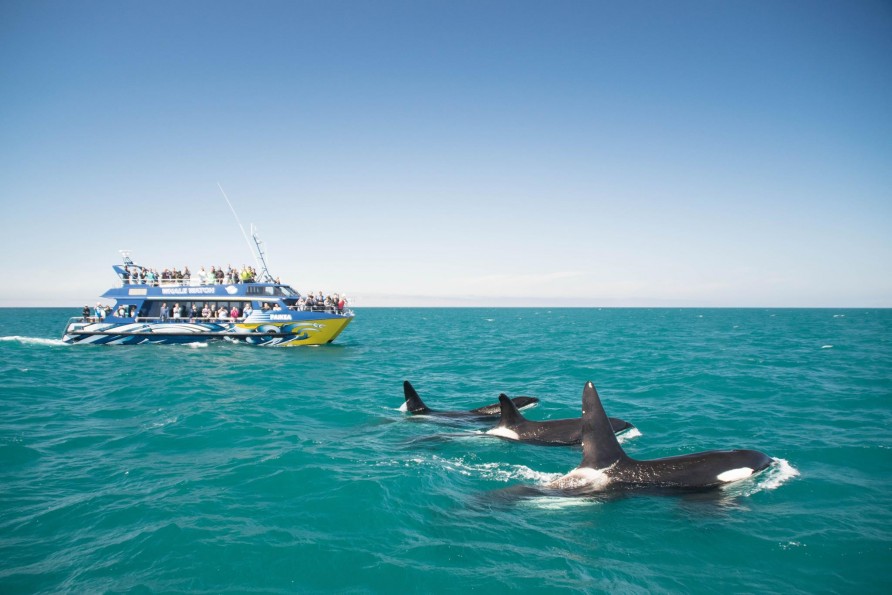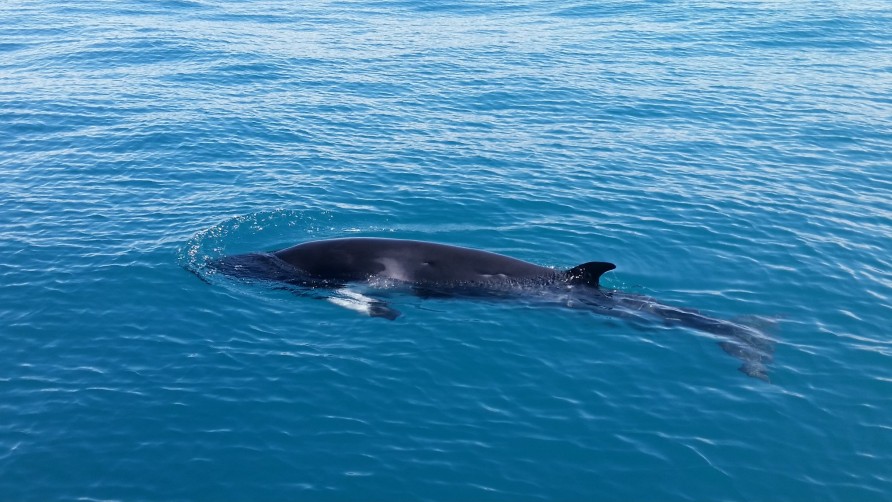Whales
Kaikōura is one of the few places in the world where Giant Sperm Whales can be seen year-round and reasonably close to shore.
They congregate here because the 2km deep Kaikōura Canyon runs right up against the coast creating a rare system of sea currents that sustain an incredibly rich marine food chain.
Sperm Whales are at the top of this food chain and the abundance of fish ensures they make the waters of Kaikōura their home.
Kaikōura is also a migration path for many different species of Whales.

There he blows. Male sperm whale off the Kaikōura coast.
Sperm whales are named after the spermaceti oil (wax) that they produce in the spermaceti organ located in their head. It is because of this oil that man hunted the sperm whales, going after the prized spermaceti oil that was used to make smokeless candles during the 19th century.
Sperm whales are one of the deepest diving whales, they usually dive hundreds of meters to find their food but have been recorded at depths of over 3000m which is phenomenal. They are also the champion breath holders generally averaging dives of between 40-60 minutes but have been recorded at ‘holding their breath’ for over 2 hours.
Sperm whales eat prey found on or near the ocean bottom, squid is their main diet but they also eat sharks and various bony fish. Unlike other species of whales that feed only during certain times of the year, sperm whales feed all the time, they can eat around 3% of their body weight each day which for an adult male sperm whale can mean around 1.5 tonnes of food per day.
Kaikōura plays host to the male sperm whales only, with the females and the young whales found in the warmer tropical waters. It is a feeding ground for the young males who come here to feed them and build themselves up making themselves more socially and sexually acceptable for later on in life.
Did you know?
- Sperm whales only have teeth on their lower jaw
- Sperm whales bodies can be broken down into 3 thirds – Head / Torso and Tail
- Sperm whales have the largest brain of any animal – up to 9kgs in weight
- The last sperm whale hunted in Kaikōura was on December 21st 1964

Size comparison between a sperm whale, giant squid & whale watch vessel
Humpback Whale
A species of baleen whale that migrates from the Antarctic to the tropics to mate and give birth in winter. Humpback Whales tend to feed within 50m of the water's surface, taking krill and shoaling fish.

They are frequently seen in Kaikōura during winter months (Jun / Jul / Aug) where they sometimes perform spectacular displays of spyhopping, breaching, lobtailing and flipper slapping. The tendency for Humpbacks to come very close to shore means they can become tangled in craypot lines. In 2003, a local Kaikōura fisherman, Tom Smith, was accidentally killed while trying to free a trapped Humpback Whale in South Bay.
The humpback has the most diverse techniques of feeding methods of all baleen whales. Its most inventive technique is known as bubble net feeding: a group of whales blows bubbles while swimming in circles to create a ring of bubbles. The ring encircles the fish, which are confined in an ever-tighter area as the whales swim in smaller and smaller circles. The whales then suddenly swim upward through the bubble net, mouths agape, swallowing thousands of fish in one gulp. This technique can involve a ring of bubbles up to 30m in diameter and the cooperation of a dozen animals. Some of the whales take the task of blowing the bubbles through their blowholes, some dive deeper to drive fish toward the surface, and others herd fish into the net by vocalizing. Humpbacks have been observed bubble net feeding alone as well.
Humpbacks have a distinctive 3-6m (10-20ft) heart shaped to bushy blow. They will generally breathe every 20-30 seconds for two or three minutes then dive in their peculiar ‘humpback’ fashion, staying under the water for 3 to 28 minutes.
Quick Facts:
- The varying shape and colour patterns on the humpback's tail flukes and dorsal fin are as individual in each animal as are the fingerprints on humans.
- Humpback Whales frequently breach, throwing two thirds of more of their bodies out of the water and splashing down on their backs.
- Humpback Whales produce the longest and most varied songs in the animal world.
Blue whale
Blue Whales are the largest, heaviest and loudest animal that has ever lived on Earth. They can be as long as a Boeing 737 and six times as heavy. Their heart is the size of a small car and their tongue as big as an African Bull elephant.

The whistle emitted by a Blue Whale is so loud it can be heard underwater across entire oceans. The Blue Whale blow is over 9 metres high and so large it forms a cloud that floats above the sea long after the whale has dived. A single Blue Whale needs to eat as much as 4.5 tons of krill a day to fuel their massive bodies, filtering them from the water with 400 pairs of baleen plates and feeding around the clock. The name 'Blue Whale' comes from their startling electric blue skin pigmentation that gives off a spectacular neon glow under water.
Once numbering around 225,000, Blue Whales have been hunted to near extinction. In the 1930-31 whaling season alone 30,000 Blue Whales were killed, mostly by British and Norwegian whalers. Less than 2,000 remain in the Southern Hemisphere today. They have been protected since 1965. Blue Whales are a member of the Fin and Sei whale family. The endangered Sei Whale is still killed by Japanese whalers. All three whales are seasonal visitors to Kaikōura.
Blue whales are sighted off the Kaikōura coastline at various times throughout the year, generally on a mission as they are passing through, when sighted on our tours it is very special indeed.
Quick Facts:
- The blue whale's heart is huuuuge! As in, the size of a car; its beat can be detected from two miles away.
- A blue whale’s tongue alone weighs as much as an elephant.
- Blue whales feast on krill; their stomachs can hold 2,200 pounds of the tiny crustaceans at a time.
- Generally ranging in length from 80 to 100 feet (24 to 30 meters), the longest one ever recorded was a magnificent 108 feet long.
- Blue whales can be found in all of our planet’s oceans, except the Arctic, usually swimming alone or in groups of two to four.
- At birth, blue whale calves measure around 8m long and weigh a massive 4,000kg!
Southern Right Whale
Right whales have large wide bodies, broad flippers and no dorsal fin on their back. They are dark grey to black in colour. A right whale's head is covered in raised patches of rough skin which are called ‘callosities’. The callosities are usually a whitish colour. Different types of whale lice live on the callosities.
Right whales have a huge mouth! Their baleen is up to 3m long and they have over 500 pieces inside their mouth. The baleen has fine hairy fringes on the ends which helps to trap their food. Right whales feed on copepods which is a type of zooplankton. Each copepod is about the size of a grain of rice and the whales eat about 3 tonnes every day when they are feeding.
This whales slow speed and the fact that its body is so rich in oil that it floats (even when dead) led it to be the “right whale” to catch. With them being an easy catch right whales suffered most of all from the centuries of slaughter.
They are an endangered species because they were hunted for meat, whalebone and valuable oil. They are slow breeders, which means that the species has been slow to recover. They have been protected since 1937 and have shown some signs of recovery.
Quick Facts:
- Their tails are up to 7m across and they often lift their tails into the air and then 'sail' across the water!
- Southern Right whales are up to 17m long, have a V-shaped blowhole due to the wide spacing of their blowholes, and a distinctive arched mouth.
- There are both northern and southern right whales.
Orca/Killer Whales
Killer whales are also sometimes referred to as the Orca, Orca whale or Blackfish.
For the avoidance of doubt, a whale, as defined by the Marine Mammals Protection Regulations 1992, means all species commonly known as whales; and includes baleen whales, sperm whales, beaked whales, killer whales and pilot whales.

They have the same large bulbous head containing spermaceti oil and a short narrow mouth with no teeth on the upper jaw. They eat small fish, deep-sea shrimps and cuttlefish.
The Killer whale is one of the only cetaceans (cetaceans include whales, dolphins and porpoises) known to hunt other marine mammals aptly nick-named the wolves of the sea as they hunt in packs much like wolves do on land.
Orca are known to hunt everything from small dolphins to Blue whales, the largest known animal in existence.
These whales have the second largest brain of all marine mammals, second only to the sperm whale which is known to have the largest brain of any living animal.
At a whaling station off Eden in Australia a resident Orca named ‘Old Tom’ would herd baleen whales into the bay in return for a reward of whale’s tongue.
Quick Facts:
- The dorsal fin in males is much larger in males than females at times measuring up to 6ft in height
- They are fast swimmers and can travel up to 55km/h
- In fact some of the most interesting foods killer whales have been known to consume include: moose, birds, whales and polar bears
Minke Whale
Until recently the Minke whale, found in all oceans of the world, was considered to be just one species. Recently, however, the Antarctic Minke has been classified as a separate species from the dwarf Minke. Both dwarf and Antarctic Minkes are found in the Southern Hemisphere.
Minke whales were hunted extensively by whalers during the 70’s and 80’s, with hundreds still being killed today under the guise of scientific research in the Southern Oceans.
Minke whales can be hard to research; they are fast, observed swimming at speeds of 30 km/h, and their surfacing can be sporadic and hard to follow. Little is known about this species due to their elusive behaviour
Quick Facts:
- Minke Whales are the smallest of the baleen whales.
- The biggest predator of the Minke Whale are Killer Whales
- Minke whales attempt to avoid these attacks by attempting to out-swim them.
- The long distance endurance of the Minke in open water is their best anti-predation tactic.

LONG-FINNED PILOT WHALES
Pilot whales are known for their jet black or dark grey or white markings on their throat, belly and sometimes behind its dorsal fin and eye.

They are very social family animals and can travel in pods of up to a hundred at a time and at times bottlenose dolphins can be seen travelling with them.
They have very strong family bonds, so when one individual strands the rest of the pod tends to follow. Farwell Spit which is at the top of the South Island of New Zealand is renowned for this happening.
Pilot whales generally take several breaths before diving for a few minutes. Their feeding dives may last for around 10 minutes with an adult pilot whale needing about 50kg of food a day. Squid is the main food source for the Pilot Whale but they also consume various types of fish. They are also known to consume crustaceans, octopus, and cephalopods.
Quick facts:
- There are two types of pilot whales – short-finned and long-finned
- They are able to dive up to 1,950 feet.
- Sometimes, they are referred to as blackfish due to their coloration.
Pygmy Sperm Whale
Pygmy Sperm Whales are miniature versions of Giant Sperm Whales.
They have the same large bulbous head containing spermaceti oil and a short narrow mouth with no teeth on the upper jaw. They eat small fish, deep-sea shrimps and cuttlefish.
When startled, the Pygmy Sperm Whale emits a dense cloud of reddish-brown intestinal fluid that acts as a decoy much like the ink of a squid. Small numbers of Pygmy Sperm Whales continue to be killed by Japanese and Indonesian whalers.
Beaked Whales
The chance of seeing any of the 11 species of beaked whales known to inhabit New Zealand waters is slight. In some cases the only proof of their existence is their bodies washed up along the coastline.
The Gray’s, Arnoux, Cavier’s and the Southern strap-toothed whale is the most common seen in New Zealand waters.
Beaked whales live in the open ocean and dive around 300m for squid.
They vary in length from 3m to 13m, they have a small head, beak and bulging forehead.

Rare sighting of a Southern Bottlenose Whale (member of the Beaked Whale family). Photo Credit: Heleen Middel
Fin Whale
Fin whales can reach up to 24 meters in length - second in size only to the blue whale.
These whales have a life span of at least 80 years. The fin on their back gives them their name - this fin is very easy to see and one of their predominant features.
Like other baleen whales, the fin whale also skims the surface and takes in huge volumes of water. When they close their mouths, the water is pushed out through the baleen and the prey is caught on the inside of the baleen. A fin whale eats up to two tonnes of food every day this way!
Quick Facts:
- The fin whale, the second largest living mammal
- Fin whales can swim at up to 30 mph (48 kmh) in short bursts
- The Fin Whale isn’t very picky when it comes to the foods it consumes. Some of the most popular foods that it eats include small fish, squid, and krill.
- You can find these whales in all the oceans around the world.

What is classified as a whale under New Zealand regulations?
Under the New Zealand Marine Mammals Protection Regulations 1992 a whale means all species commonly known as whales; and includes baleen whales, sperm whales, beaked whales, killer whales, and pilot whales.

